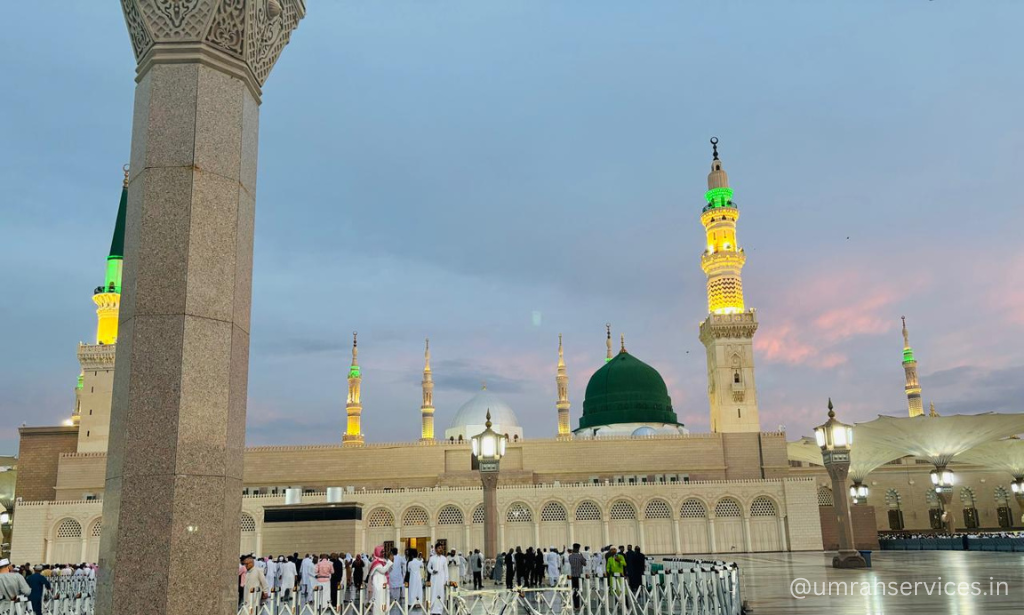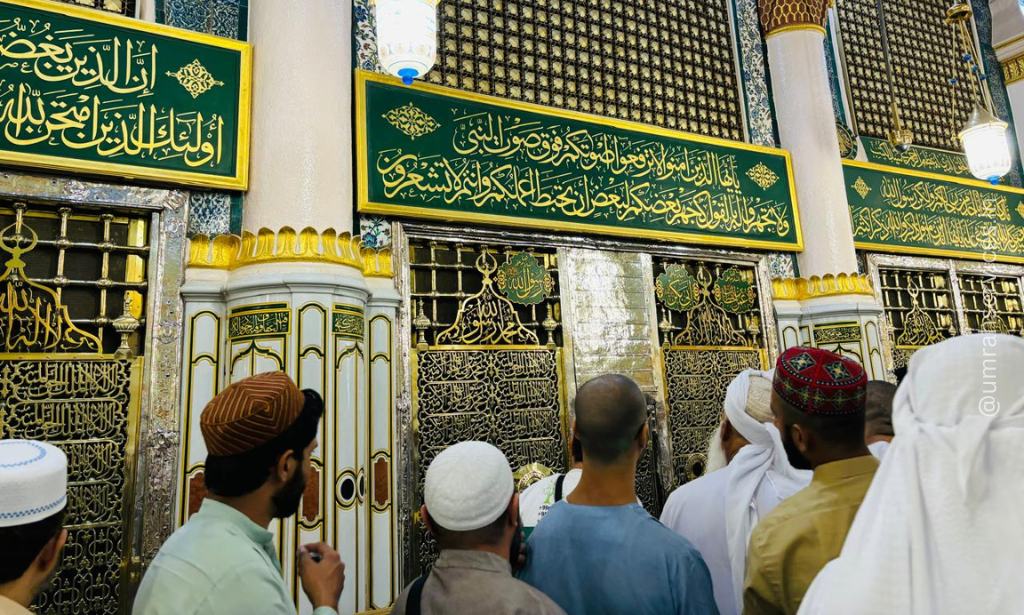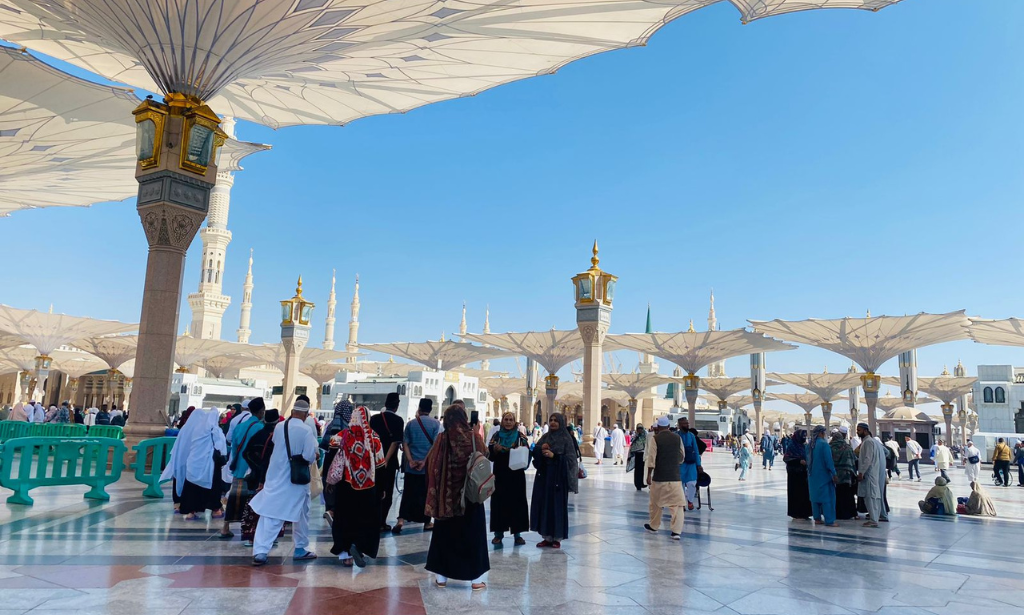Al-Masjid an-Nabawi, also known as the Prophet’s Mosque, is one of the most sacred and significant mosques in Islam. Muslim around the world consider Al-Masjid an-Nabawi, located in Medina Saudi Arabia as a site that holds unbelievable spiritual significance and historical importance. Millions of Muslims undertake pilgrimage to this place annually because Prophet Muhammad (PBUH) built this mosque himself.
The mosque functions as both a house of worship and a heritage landmark which displays the simple yet grand architectural style found in early Islamic buildings. Throughout several centuries the mosque went through many modifications which has turned it into one of the world’s biggest and most beautiful mosques in the world.
The blog explores the historical development of Masjid an-Nabawi together with its meaningful aspects as well as its interesting facts about the mosque while analyzing its facilities and the noteworthy items inside its walls.
What is the Meaning of Masjid an-Nabawi ?
Masjid an-Nabawi is an Arabic name which directly translates to “The Prophet’s Mosque”. The mosque receives its name from the fact that Prophet Muhammad (PBUH) founded it and houses his final resting place. Nabawi originates from Nabi which means Prophet thus establishing its direct association with the Messenger of Allah.
Also Read:- Umrah ki Duas
What is the History of Al-Masjid an-Nabawi?

After Prophet Muhammad (PBUH) migrated to Medina from Mecca (Hijrah) in 622 CE (1 AH), construction for Masjid an-Nabawi started. Two orphan brothers Sahl and Suhayl sold the land for the mosque, and the Prophet (PBUH) worked actively with his companions during its construction phase.
In its original state the mosque maintained an open-air structure with walls made up of palm trunks and mud. It also consisted of a shaded space (Suffah) to accommodate poor companions. The mosque has undergone many expansion under the leadership of various caliphs and rulers throughout the centuries.
Expansions Over Time
The mosque has undergone several expansion under different Islamic rulers. Some of the notable expansions are as follows;
- The first expansion of the mosque occurred in the seventh century through the order of Caliph Umar ibn al-Khattab (RA) because it needed more space for growing number of worshippers.
- During the 8th century Caliph Uthman ibn Affan (RA) performed reconstruction work by building the mosque with stone and wood.
- During the Umayyad & Abbasid eras, the mosque uunderwent minor renovations and decorative additions.
- During the Ottoman Era Sultan Abdulmajid I refurbished the mosque while adding the well-known Green Dome to the structure.
- King Abdulaziz and the Saudi rulers after him expanded the mosque during the 20th and 21st centuries by creating spaces that could fit 1 million worshippers with modern amenities including air conditioning systems, escalators and retractable domes.
All these and many more expansions over the centuries have transformed a modest mud structured mosque into becoming one of the largest and most beautiful mosques in the world.
Importance of Masjid an-Nabawi

Masjid an-Nabawi holds a special place in Islam for several reasons:
- It is the second holiest Islamic shrine to exist after Masjid al-Haram located in Mecca.
- Religious scholars believe one receives 1000 times more reward for praying at Masjid an-Nabawi than in any mosque except Masjid al-Haram.
- The complex that includes the Green Dome preserves the burial chamber of Prophet Muhammad (PBUH) and Abu Bakr (RA) and Umar (RA).
- The mosque served as the first center for teaching Islamic lessons as Prophet Muhammad (PBUH) educated all of his companions there.
- At its inception the mosque operated as both the political and judicial center for the early Muslim state.
10 Interesting Facts About Masjid an-Nabawi
- The mosque became one of the initial buildings across the Arabian Peninsula to gain electrical power back in 1909.
- The expansion process of this mosque has happened more than 100 times following its original building phase transforming it from a modest mud structure to one of the largest mosques in the world.
- The famous Green Dome that serves as a defining identity of Al Masjid an Nabawi gained its green color during the Ottoman era after the restoration of 1837. Before green it was white is colour.
- The Qibla direction at the mosque first pointed toward Jerusalem until its redirection towards Mecca happened.
- A section named “Riyaz Ul Jannah” (Garden of Paradise) lies between the Prophet’s tomb and his pulpit. It is one of the most blessed prayer spaces with high rewards.
- The incredible design feature of Masjid an-Nabawi consists of 27 movable domes combining traditional Islamic patterns with modern engineering techniques. The domes are not just decorative elements but they also function to manage light availability, temperature control and ventilation throughout the massive prayer hall spaces.
- The courtyard utilises 250 air-conditioned automated umbrellas to provide shade to the worshippers.
- Visitors can find supplementary prayer areas located in the lower sections below ground level at Al Masjid an Nabawi.
- Modern audio technology prevents the Adhan from producing any echoing sounds inside the structure.
- World’s largest hand knotted carpet covers the mosque floor. It is handmade and weighs around 35 tons.
Why Is It Called “Nabawi”?

The mosque is called Masjid an-Nabawi because Prophet Muhammad (PBUH) had profound spiritual ties to this place. The Arabic word Nabawi is derived from Nabi which means Prophet and thus linking the mosque to Allah’s final Messenger. This sacred site encompasses the Prophet’s former residence, his final resting place beneath the famous Green Dome, and the original center of his teachings.
Early Islamic civilisation flourished from this sacred site which functioned as a religious sanctuary because Prophet (PBUH) conducted prayers for Muslims, preached from there and established governance for the Muslim community.
The name “Nabawi” professes eternal praise to the Prophet’s mosque which maintains the Prophet’s legacy as the second most important Islamic site following the Kaaba in Mecca.
Accommodations in Masjid an-Nabawi
The mosque complex includes several facilities for worshippers:
Prayer Facilities
- The main prayer hall possesses the capacity to hold more than 1 million worshippers.
- The site provides separate and spacious areas where women can engage in prayers.
- The mosque also consists of outdoor prayer spaces for crowds to overflow.
Visitor Amenities
- Hotels & Guest Houses of different prices and categories are located in close proximity to the mosque.
- Free Zamzam Water Stations are available throughout the mosque.
- Free internet access and Islamic libraries for visitors.
- The Mosque is accessible to wheelchair users. There are plenty of ramps and special prayer areas for the disabled.
- The facility implements advanced management systems, which efficiently manage the huge crowds, especially during Ramadan and Hajj. Personnel trained to assist visitors overlook crowd management.
What Is Special About Masjid an-Nabawi?

Masjid an-Nabawi, also known as the prophet’s mosque is special in many regards. It is considered the second holiest site in Islam. The mosque was built by the Prophet Muhammad (PBUH) himself and houses the prophet’s tomb.
- A visit to a mosque is regarded as a Sunnah with immense blessings resulting from this practice.
- Praying in the Rawdah, an area within the mosque between the Prophet’s tomb and his pulpit, believed to be a part of paradise is highly rewarding.
- The site preserves Islamic historical artifacts including the Prophet’s tomb and the remnants of the mosque’s original structure.
- The pulpit which Prophet Muhammad (PBUH) used remains in this place.
- The architecture of the mosque is also quite mesmerising as it blends ancient and modern Islamic architecture.
Also read:- Ziyarat Places in Medina
What Important Things Are Inside Masjid an-Nabawi?
- The Prophet’s Tomb – Al Masjid an Nabawi houses the tomb of Prophet Muhammad (PBUH) under the green dome.
- Pulpit (Mimbar) of the Prophet – The pulpit which was used by Prophet Muhammad (PBUH) to deliver sermons is still well preserved in the mosque.
- Riyad al-Jannah – Riaz Ul Jannah is a blessed piece of land located in Masjid Al Nabawi in Madinah. It is one of the most sacred places on earth for Muslims. It refers to the area between the Pulpit and the tomb of Prophet Muhammad (PBUH).
- House of Fatima (RA) – The mosque has many important and significant places located within its walls. One suc important inclusion in the House of Fatima (RA). It is considered a very sacred and essential place to visit inside Masjid Nabawi.
- Mehrab-e-Nabawi – After the Qiblah was switched to Masjid Al-Haram, Prophet Muhammad (PBUH) used to lead his congregational prayers from Mehrab-e-Nabawi. Even to this day, Imams of Masjid an-Nabawi lead the prayers from this spot.
Conclusion
The sacred structure of Masjid an-Nabawi exists not only as a mosque but also an active commemoration of Islamic heritage. The dream of countless Muslims includes visiting this holy place that connects them to Prophet Muhammad (PBUH) and the early days of Islam.
The mosque is home to a lot of Islamic artefacts and places of great importance that carry stories of the early days of Islam. All these factors combined together add to the charm and grandeur of Al Masjid an Nabawi attracting millions of pilgrims every year.
Frequently Asked Questions
Q. Can non-Muslims enter Masjid an-Nabawi?
A. No, only Muslim worshippers are allowed to enter perimeter of the mosque.
Q. Is there a dress code for visiting the mosque?
A. Yes, since it is one of the holiest sites in Islam, modest Islamic attire is mandatory. Men should wear Ihram or similar loose clothing while women must wear an abaya and hijab.
Q. What is the best time to visit Masjid an-Nabawi?
A. The best time to visit is either early in the morning or late at night. It will help avoid the massive crowd that gathers at the mosque everyday, especially during the month of Ramadan.
